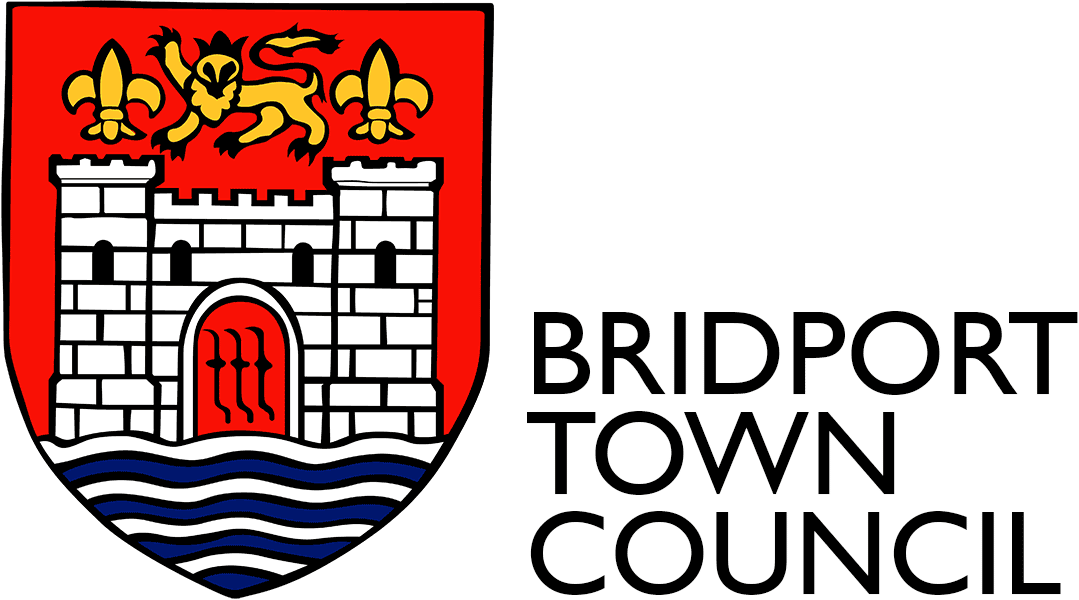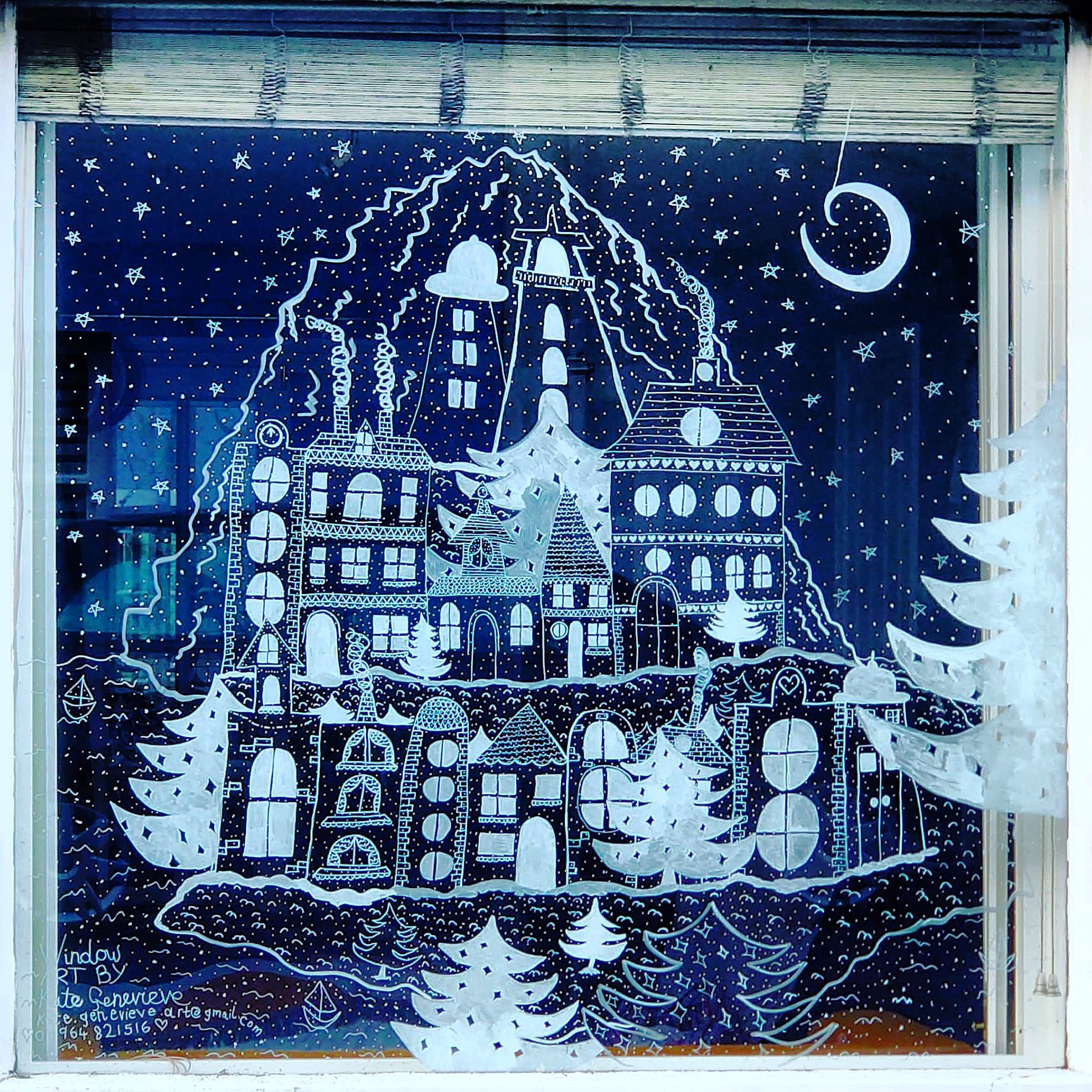
I’m Dreaming of a Green Christmas
The build up to Christmas is well and truly under way and my young granddaughters are getting really excited counting down the sleeps until the big day. The trees and lights are up in our high streets and as Mayor I have had the honour of flicking the switch to light up the Christmas tree parade in the United Reform Church and pressing the magic plunger to light up the big tree in Bucky Doo Square.

The display of charity Christmas trees in the United Reform Church is once again a feast for the eyes with the church filled with creatively decorated charity trees. The switch on ceremony included a short carol service and what a pleasure it was to be singing those timeless songs once again. Afterwards Anne and I had a good look at all of the beautifully decorated trees, but one tree made us stop in our tracks and absorb the sadness behind every photograph on it, because each and every image of a happy, smiling young person was of someone who had taken their own life.

By 6.00pm a sizeable crowd gathered in Bucky Doo Square and it was down to me to lead the countdown and press the plunger to turn on the lights on the big tree. The trees around the town and the big one in Bucky Doo Square plus the twinkling street lights are all thanks to money raised by the Christmas Cherr Committee in collaboration with the Town Council and all put together by the amazing Town Council works team. A big thank you to all involved in making the town look so fesitve once again especially during these dark times.
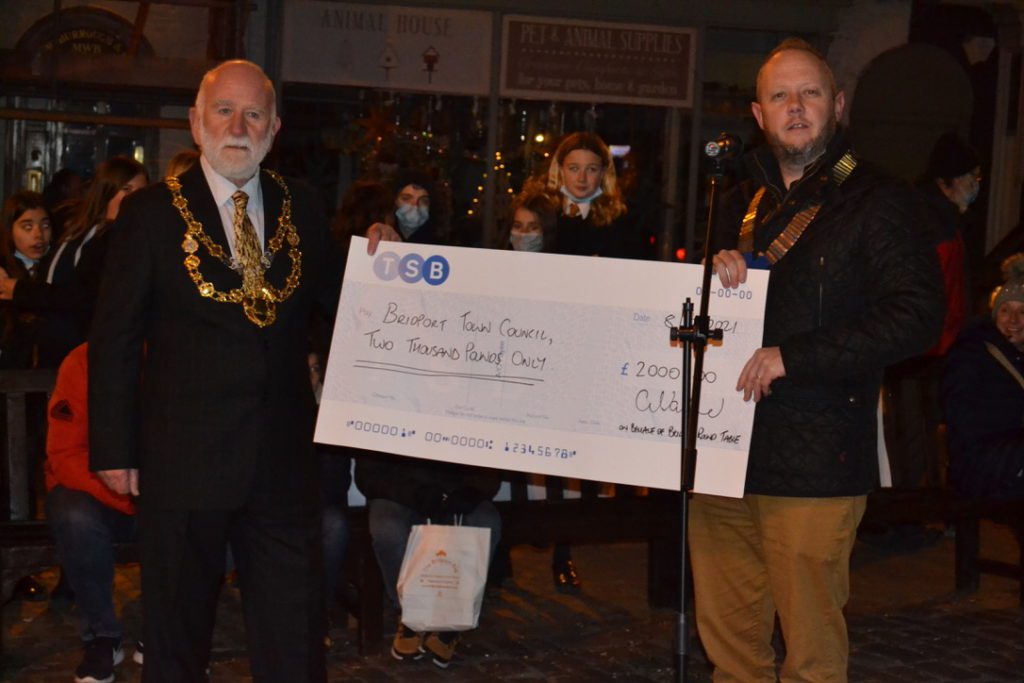
In addition to lighting the tree I received a cheque on behalf of Bridport Town Council for £2,000 from Bridport Round Table to go towards the redevelopment of the Plottingham Fields skatepark.

The Round Table also presented Arthur Woodgate of the Bridport Young Persons’ Action Trust, and pupils from Bridport Primary School, with a cheque for £400 as a contribution towards the work being done to refurbish and enhance Brandon’s Trail at Bridport Primary School. The refurbishment of Brandon’s Trail is both a Rights Respecting Town Project and is the Town Council’s Community Project of the Year.
Work on the site began in the Summer Holidays and this will see the revitalisation of the memorial to Branden Wayland, a pupil who died of cancer at the age of five in 2008. His legacy also providing a calm refuge for other children in need of support. The School Council felt strongly that it should be available to anyone who might need it.
This year, I invited pupils in the three Bridport Primary Schools to come up with a design which reflected Bridport and Christmas for the Mayor’s Christmas Card. I received just over 100 entries and after much deliberation the winning entry was selected. Theo Poole, aged 11, a pupil at St Catherines School, produced the winning design which can be seen below. It was pleasure to meet Theo and hand him his prize and 20 copies of the card. Well done, Theo and a big thank you to all the other pupils who entered.
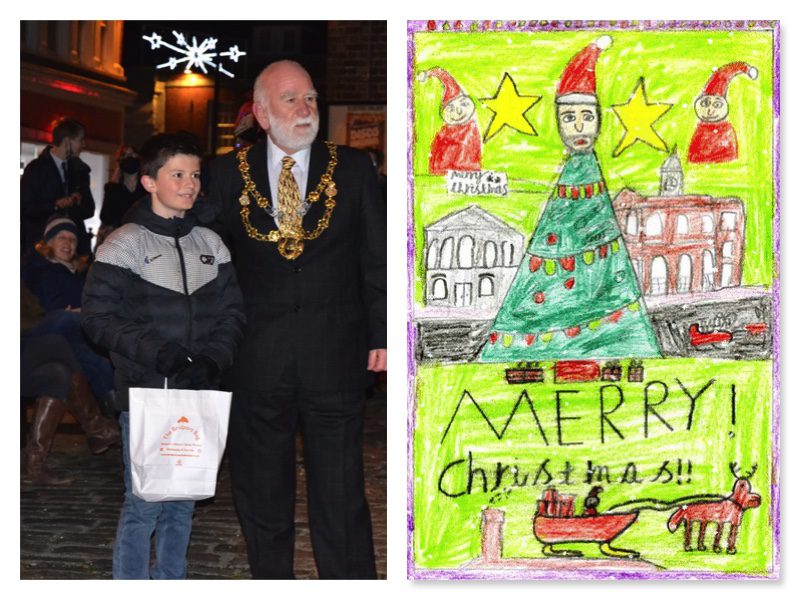
How To Have A Greener Christmas
Christmas is a time of excess; celebrating, eating, spending and gifting. But it doesn’t have to be done in a socially, economically and environmentally reckless fashion. It is perfectly possible to enjoy yourself, enjoy time with family and friends and still save money and be kinder to the environment.
The Christmas Tree
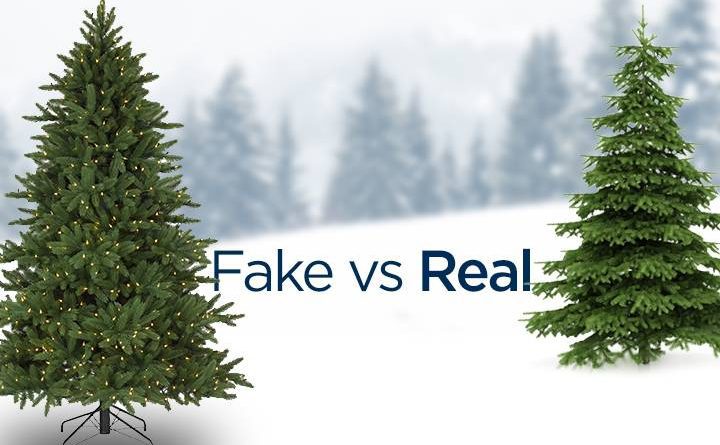
It wouldn’t seem like Christmas without a tree, but which is the best option for the environment – real or fake – based on their full life cycle from production to disposal?
Potted Christmas trees are the best option for the environment. They won’t be thrown away after Christmas and, if you’re green fingered, can be reused for next year. In the meantime, it will continue to grow and take in the greenhouse gas carbon dioxide, creating a mini carbon sink. The Royal Horticultural Society has this guide to help care for your potted and cut Christmas trees. Survival rate of these trees isn’t great as they do require care and attention throughout the year.
Cut Christmas trees are the next best option because they aren’t made of fossil fuels and whilst growing take in carbon dioxide, taking in an estimated 1 tonnes of carbon dioxide per acre. Cut trees should then be recycled by home composting it or cutting it up and placing it in your garden waste bin or taking it to a household recycling centre. Alternatively you can book a Christmas tree collection with Weldmar Hospice https://www.weld-hospice.org.uk/become-involved/trees/
If you already have a plastic Christmas tree, it is important that you keep on using it. It is the least environmentally friendly option as it is made from fossil fuels, giving a large carbon footprint for production and disposal. However, the fact that they don’t decompose is also their strong point as they will last for years. You will need to use the tree for between 12-15 years to account for its carbon footprint, but even longer would be better.
The Decorations
Old decorations – If your existing decorations are plastic keep using them. They will last for a long time which is their good and bad point combined. They are likely to keep going for hundreds of years so make the most of them. However, if you really don’t like them, let someone else enjoy them by passing them to a charity.
New decorations – If you are looking to update your decorations, look for those that are made of wood, glass, paper or other natural materials. Alternatively, make your own out of paper or salt dough – but remember to ditch the glitter!
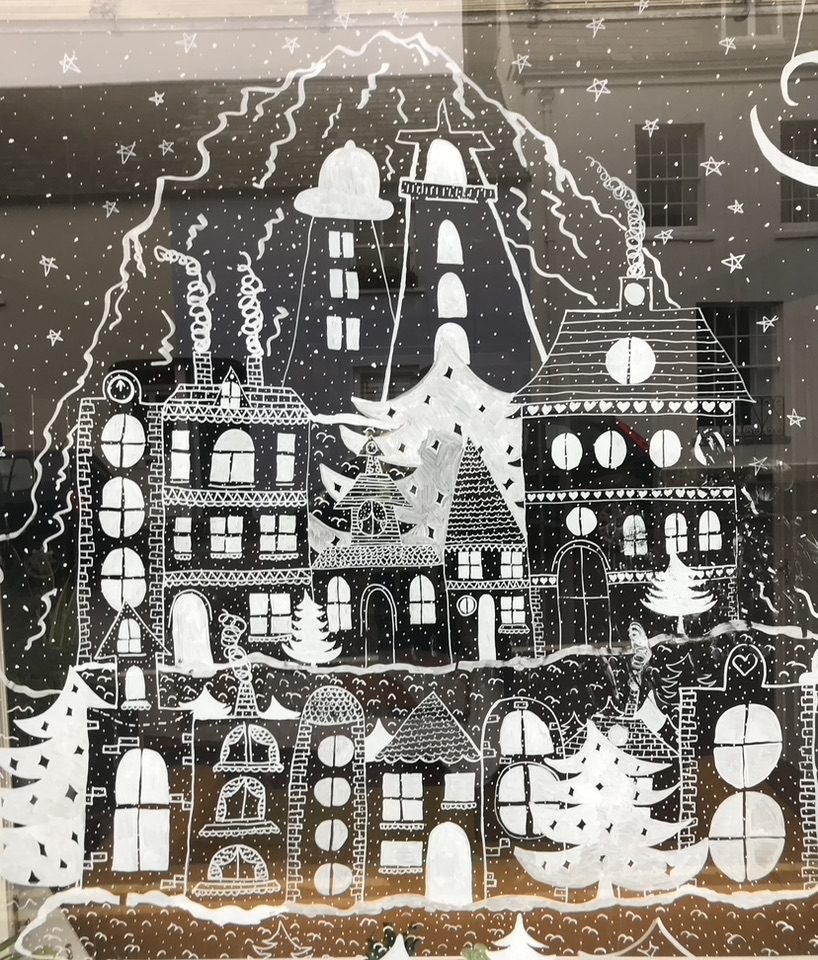
Window drawings have made a really big impact in town this year. There are several amazing Christmas window scenes around the town drawn by Kate Genevieve. I love them.
The Food
Half of Britons say that they buy more food than they need at Christmas. It might be a sentiment leftover from the days when supermarkets shut on Boxing Day, sending the nation into survival mode. However, most supermarkets now open on Boxing Day, even if for limited hours, which means you really don’t need to over-buy food.
A practical way to avoid over-buying food is to plan your meals. Writing down what you need, planning a meal for each day, checking cupboards for items you will need so you don’t double up and sticking to the list when shopping will really help you avoid unnecessary purchases.
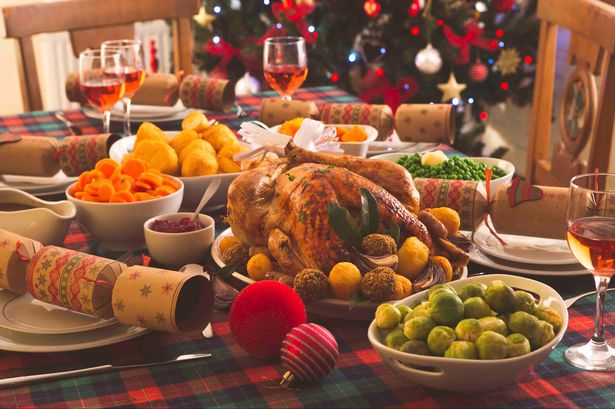
Remember shopping locally especially from high street greengrocers, butchers, bakers, delicatessens, farm shops and market stalls lends much needed support to truly local food producers and retailers and helps to reduce food miles. This applies as much to vegetarians and vegans as it does to meat eaters.
Once again this year most of the vegetables on my Christmas plate will come from my allotment.
Tip: leave skins on your potatoes when making the roast potatoes. You can’t really tell they are still on, it avoids food waste and increases the iron content by up to 80%. Win Win.
The Leftovers
Two million turkeys. Five million Christmas puddings. Over 74 million mince pies. Brussel sprouts and other vegetables, both locally grown and exotic varieties flown in from all over the world, add to the huge amount of food that finds its way into the waste system. That is just a taste of the food that was thrown away last year in the UK that could have been used up as leftovers.
It isn’t just that the food is adding to the waste mountain. It is a huge waste of the resources it took to grow, manufacture and deliver the food even before it reached your dinner table. For example, the typical British Christmas turkey dinner for a family of four weighs in at around 15,000 litres of ‘hidden’ water. With that in mind, it’s important to make the most of the food you have and try to eat everything that you can. And leftovers are a brilliant way to achieve this.
The Gift Wrapping
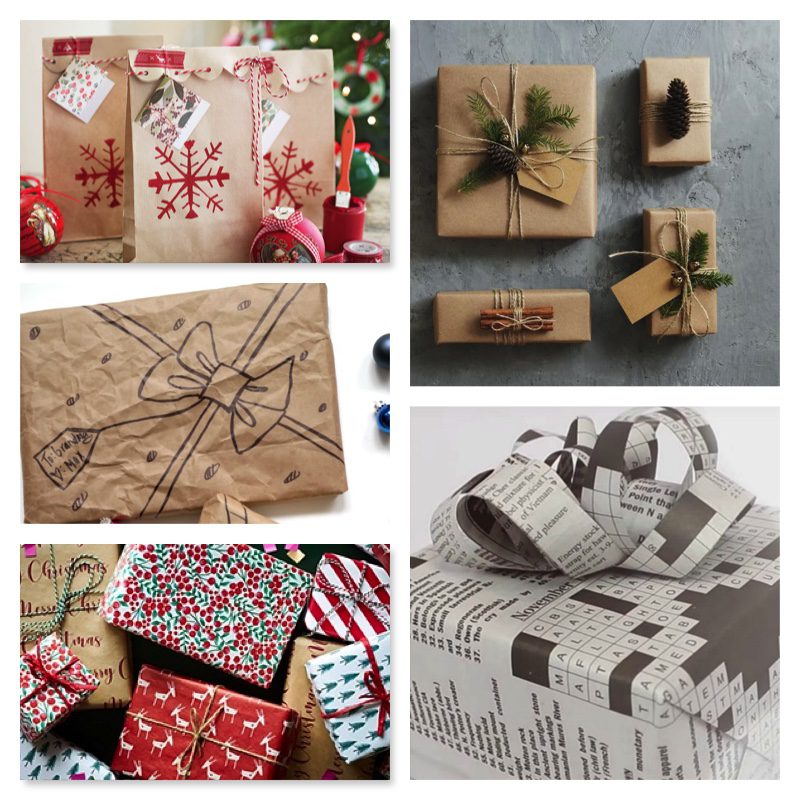
It is possible to give beautifully wrapped gifts that are still eco-friendly. Avoiding plastics is a good place to start but also think about buying wrapping that can be either reused, such as a scarf, or recycled. Newspaper, brown paper and wallpaper all make great wrapping paper – being creative is part of the fun.
The Presents
Be kind to your purse, the environment and help out charities by gifting preloved items at Christmas. Charity shops and Reuse Shops are a treasure trove full of unusual items that will cost a fraction of their original price. Go with a budget and an open mind. You might even pick up a fabulous outfit for that Christmas party (!) Nothing is appreciated more than a hand made gift so support local makers or better still have a go yourself.
The Debris
Wrapping paper – Not all wrapping paper is recyclable. Although most are paper-based, they can be coated in plastic, making it very difficult to separate out the paper for recycling. Test if you can recycle it by scrunching it up – if it springs back it can’t be recycled, but could be saved for reuse.
Try to buy wrapping paper that is 100% paper and glitter-free. Please check wrapping paper before recycling. Father Christmas shows you how – click on the image above.
Cards – Most cards are paper based and can be recycled, along with their envelopes, either in your household kerbside recycling collection, at local recycling points such as household waste recycling centre or at collection banks in supermarket car parks.
Any embellishments such as ribbons or glitter cannot be recycled so should be removed first by simply tearing off that section. Batteries should also be removed from musical cards and disposed of at battery recycling points.
Aluminium Foil – is one of the most important materials to recycle due to the environmental benefits it offers. The good news is clean household foil and aluminium trays are widely in your household kerbside recycling collection, at local recycling points such as household waste recycling centre or at collection banks in supermarket car parks and at. Collect any small pieces of foil in a tin can so they don’t get lost.
Batteries – according to Directgov, over 12,000 tonnes of CO2 emissions could be avoided, if the UK can meet its recycling target of at least 45 per cent of batteries. There are different types of batteries which can contain dangerous chemicals including: lead,cadmium, zinc, lithium and even mercury. So, it is really important that they are disposed of correctly through recycling schemes and not placed in the residual bin. Since battery recycling laws came into force in February 2010, most shops and supermarkets that sell batteries have collection bins in-store for used batteries.
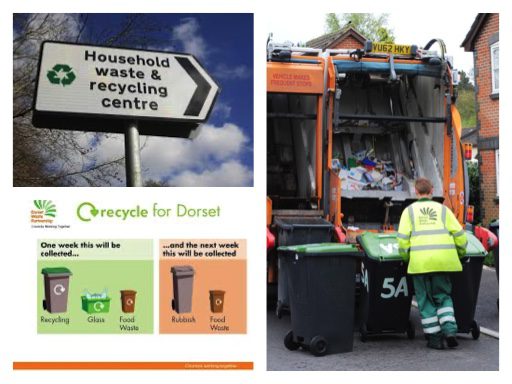
If in doubt about any of the above or whether other items can be recycled go to:
https://www.dorsetcouncil.gov.uk/christmas-information/christmas-and-new-year-rubbish-and-recycling
I
And Finally – Time to Reflect and Prepare for Christmas 2022
The above just scratches the surface of what you can do in order to reduce the environmental impact of your Christmas festivities. As the big day approaches and in the aftermath try and take a few minutes to reflect upon your Christmas this year. Ponder the changes you could make next year in order to enjoy a greener festive season. I know I can do better and will certainly will be giving it some serious thought.
